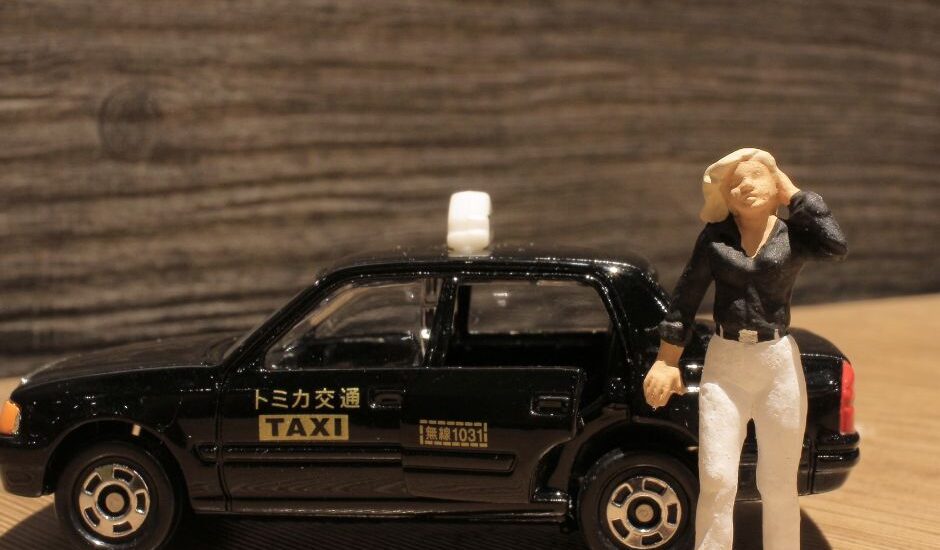Spending over $70 dollars for a taxi ride might seem excessive, but once train and bus operations stop for the day, you are left with this option to get to your destination. With that said, here’s how you can book a taxi in Japan.

You can easily tell if a taxi is available by looking at the sign on the vehicle’s dashboard. Usually, a green plate indicates that the taxi is occupied, while a red sign means it’s available for booking.
Here’s a more detailed description of the taxi signs:
空車: The taxi is available for hailing.
予約者: The taxi is not available for hailing.
賃走: the meter is on and running.
支払: The previous passenger is currently paying, and the taxi will be available soon, so you can wait near the vehicle already.
回送: The taxi is unavailable for hire because the driver is eating, resting, done for the day, or the vehicle must be refueled, etc.
割増: An indication that the fare will include a surcharge because of the schedule (usually after 10 pm to 5 am).
高速: Another indication that the time-based fare is increased because you are on a highway.
介護: A “nursing care” sign for other motorists to be aware that the taxi is transporting a vulnerable passenger, such as the elderly or those with special needs.
貸切: A chartered taxi that is only available for time-based or distance-based bookings such as sightseeing tours or family trips.

Apps you can use
Maneuvering the app is often pretty straightforward, where you pin or input your pick-up location as well as your drop-off place. You can also just choose a pick-up location and inform the driver of your destination upon boarding. Apps like Go Taxi, Uber, Didi, or S.Ride (for Tokyo) are convenient to use if you’re located in an area far from a taxi stand (タクシーのりば), which is usually within the proximity of train stations.
The app will show the GPS of the taxi on the way to you, and you can also confirm by the plate number showing on the screen. Take note that an extra fee will be added to your fare for the pick-up services, so expect your total bill to be higher than usual.
In the Tokyo area, the fare is typically ¥400-700 for the first one to two kilometers and will increase by ¥80-100 for every 200-400 meters traveled. Passing expressways with tolls are added to the fare. Furthermore, hailing a taxi after 10 pm has a 20 percent extra charge.
Needless to say, Japanese taxis have gained a reputation for being one of the most expensive in the world, and the fare can easily reach over ¥10,000; hence, it is usually a last-case option for transportation.
Things to remember when using a taxi in Japan
Perhaps the first thing that surprises foreigners using a taxi in Japan is the closing of the door issue. Once the cab is in a stationary position for boarding, it is important to remember that the left side (opposite the driver’s seat) is automatic and will be opened and closed by the driver. The left passenger side is the common boarding and alighting side, so keep in mind not to operate the door.
It is also recommended to prepare your destination address in advance in case you do not speak Japanese and are headed somewhere other than a tourist landmark. You can take a Google Maps screenshot of the address in Japanese, which you can show the driver.

Paying for the ride
Most taxis in Japan have upgraded their tech and now accept multiple payment methods such as all major credit cards, IC cards like Suica or Pasmo, or even QR codes like PayPay. The accepted payment methods are often shown through stickers on the vehicle for reference. Of course, cash is still accepted, although avoiding paying big bills for small fares is recommended.
Useful phrases for taxi use
Here are some phrases which will be helpful when communicating with a taxi driver in Japan.
– ___ made onegaishimasu. (Please take me to ___)
– Koko made de daijoubu desu. (Right here is fine, thank you)
– Directions: migi (right), hidari (left), massugu (straight), tonari (next),mae (front), ushiro (back)
– Shiharai ka-do de onegai shimasu. (I will pay by credit card, please)
– Shiharai genkin de onegai shimasu. (I will pay by cash, please)
That about sums up everything you need to know when riding a taxi in Japan. It might be a challenging task at first. Still, taxi drivers in Japan are more often than not very professional and accommodating, so you can also rely on them for extra assistance regarding the ride.
Related Articles
Warning: Undefined array key "sfsi_threadsIcon_order" in /home/veremosglobal/tokyoroomfinder.com/public_html/blog/wp-content/plugins/ultimate-social-media-icons/libs/controllers/sfsi_frontpopUp.php on line 165
Warning: Undefined array key "sfsi_blueskyIcon_order" in /home/veremosglobal/tokyoroomfinder.com/public_html/blog/wp-content/plugins/ultimate-social-media-icons/libs/controllers/sfsi_frontpopUp.php on line 170
Warning: Undefined array key "sfsi_bluesky_display" in /home/veremosglobal/tokyoroomfinder.com/public_html/blog/wp-content/plugins/ultimate-social-media-icons/libs/controllers/sfsi_frontpopUp.php on line 266



